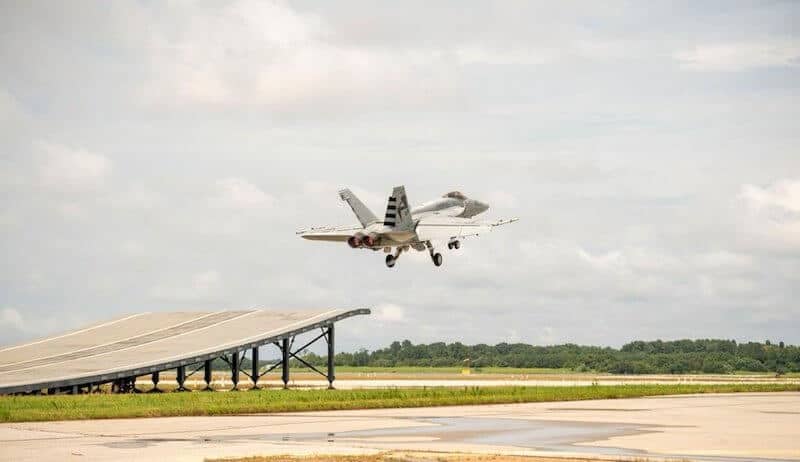
It was in 2008 that Boeing officially communicated to the Indian Navy that F/A-18 Super Hornet fighters could operate off the (then under refurbishment) Admiral Gorshkov aircraft carrier. Twelve years later, Boeing has had the US Navy demonstrate a crucial aspect of operations off the Gorshkov (now INS Vikramaditya) — launching the steam catapult-launched Super Hornet off an angled ski-jump. The demonstration was a crucial requirement for Boeing to earn consideration in the Indian Navy’s MRCBF, a contest to procure up to 57 multirole carrier based fighters for current and future aircraft carriers.
Briefing Indian journalists today nearly a month after the US Navy published first details on the ski-jump test conducted in August, Boeing’s Indian fighter programs chief Ankur Kanaglekar said, “Since 2018, Boeing teams have been conducting simulation analysis in partnership with USN, in preparation of the ski-jump trials. The entire test program was developed with safety as a foremost priority. We used a buildup test approach, starting with very conservative conditions and gradually working up to heavier takeoff weights and shorter takeoff distances. The ski jump trials involves an ‘instrumented’ F/A-18 Super Hornet jet (i.e. aircraft that has sensors attached to capture the strains) to measure the increased strain of STOBAR operations. Depending on test objectives, several jumps with different aircraft configuration took place. Each jump was carefully scrutinized by the joint Boeing and USN test team before attempting the next takeoff. The vast amount of data gathered here will help refine the modeling and simulation studies.”
Twelve years ago in 2008, Livefist had reported on Boeing’s simulation findings on the Super Hornet’s compatbility with the Gorshkov/Vikramaditya deck. A portion of those simulations have basically been done in real life with the ski-jump test. While Boeing believes that it has satisfactorily answered other compatbility questions, including deck handling and the Super Hornet’s size vis-a-vis the hangar lift on the Vikramaditya and Vikrant, questions remain.
You can watch our detailed video interview with Boeing’s Kanaglekar from five months ago here.
As Livefist has reported, Boeing’s F/A-18 Super Hornet energies in India are focused on the Indian Navy, with the F-15EX to be projected at the Indian Air Force’s separate 110 MRFA (multirole fighter aircraft) requirement. You can read about Boeing’s twin-pronged plans here.
If the Indian Navy’s MRCBF remains on track as a contest, Boeing’s Super Hornet reasonably goes head-to-head with the naval variant of the Dassault Rafale, the shore-based variant of which entered service with the Indian Air Force earlier this year. Aware of the obvious headwinds provided by the reality that the Indian forces currently have two carrier-capable fighter types on hand, Boeing has shaped its pitch around five ‘differentiators’ communicated both to the Indian Navy, as well as in the press briefing today. The differentiators are (a) Boeing making available both single and twin seat versions of the Super Hornet, (b) the fact that the Super Hornet fits in with other US origin assets in the Indian Navy, particularly the P-8I to have a force-multiplier effect, (c) the Indian Navy gains from multi-billion investments made by the US Navy in the Block III Super Hornet, (d) claimed superior economics, and (e) the interoperability boost that such a procurement would provide between the Indian and US navies.
The Indian Navy currently operates a single aircraft carrier, INS Vikramaditya, and is to commission its first indigenous aircraft carrier, the new Vikrant class, in a few years. A debate continues to rage within the procurement system over whether the navy requires a third aircraft carrier (ostensibly a flat-top carrier named the Vishal class), with budgetary pressures likely to shape next steps despite a navy leadership that has lately insisted that a third aircraft carrier is non-negotiable.
